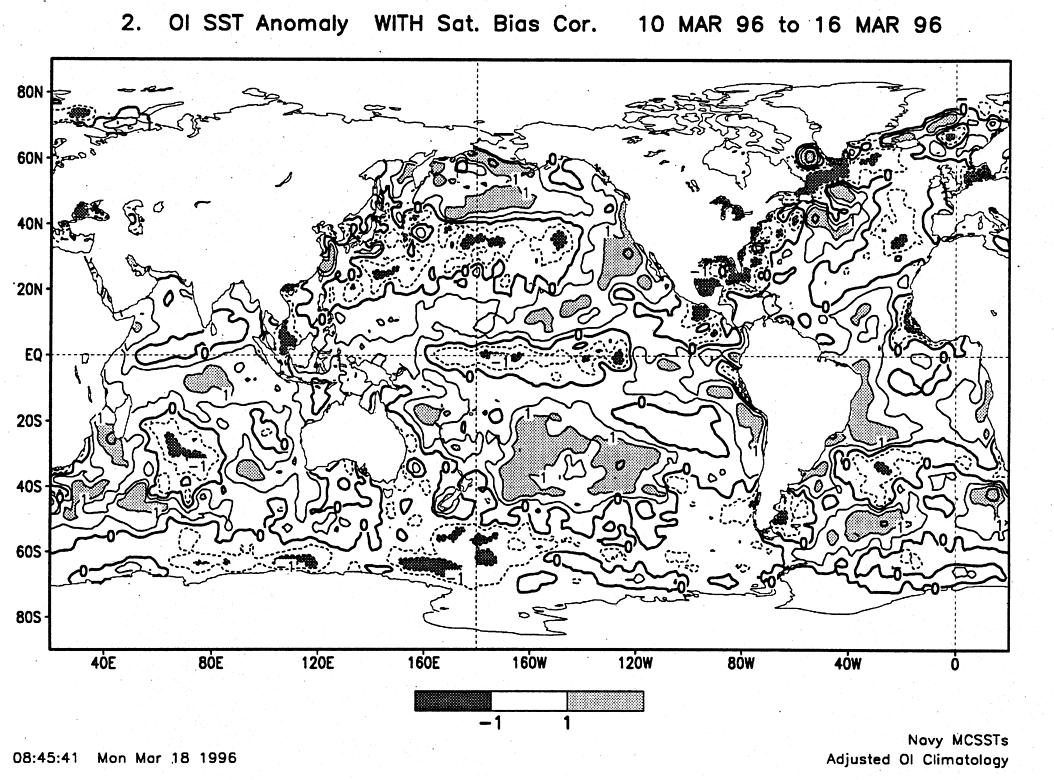Figures

Figure 1. NCEP optimum interpolation (OI; Reynolds and Smith 1994) global SST anomaly field for the week of March 10-16, 1996.
Because the CCA (Barnston 1994) and OCN (Huang et al. 1995) methods are now being used for the official operational long-lead seasonal forecasts issued by the Climate Prediction Center of NCEP, they will no longer be presented in detail in this Experimental Forecast Bulletin. However, a brief summary of these forecasts, as well as that of the NCEP coupled model (Ji et al. 1994a,b), for Apr-May-Jun and Jul-Aug-Sep 1996 is provided. For further information about the official NCEP forecasts, the following U.S. Regional Climate Center (RCC) Offices may be contacted:
Northeastern RCC 607-255-5950
Southeastern RCC 803-737-0800
Southern RCC 504-388-5021
Midwest RCC 217-244-8226
High Plains RCC 402-472-8294
Western RCC 702-677-3106
The forecasts themselves are contained in the Climate Outlook, available on Internet with address: http://cops.wwb.noaa.gov. (The previous address, http://nic.fb4.noaa.gov, will soon be discontinued.)
U.S. Surface Climate Forecasts for Apr-May-Jun '96
Temperature: CCA predicts anomalous warmth in Texas, the Southwest, much of the far West, and all of Hawaii except for near normal at Lihue. OCN forecasts warmth in the Pacific Northwest, the Northeast and mid-Atlantic states; cold in Florida panhandle; near-normal in the southern Appalachians. The coupled model dynamical forecast is not used explicitly this time due to a possible cold bias over land. Its 500mb height forecast, which is trusted, implies coolness over the northern tier of states.
Precipitation: Both OCN and CCA predict wetness in the Pacific Northwest; CCA forecasts normal wetness in Honolulu. The coupled model height forecast implies wetness over the Great Lakes.
U.S. Surface Climate Forecasts for Jul-Aug-Sep 1996
Temperature: CCA predicts anomalous warmth in the mid-Atlantic, the Florida peninsula, Reno and central California, the southern and panhandle coasts of Alaska, and most of Hawaii. OCN forecasts warm in Southwest, most of East. The same comment applies to the coupled model as that given for Apr-May-Jun.
Precipitation: CCA predicts anomalous wetness at Hilo, and dryness in central Alaska. OCN predicts above median rainfall in Michigan, below median in North Carolina and parts of the western Great Basin. The same comment applies to the coupled model as that given for Apr-May-Jun.
Note: The above forecast descriptions include only regions whose estimated cross-validated correlation skill exceeds 0.3. Highest local skills are usually in the neighborhood of 0.6, but this varies with season, lead time and forecast tool.
ENSO-Related SST
CCA (Barnston and Ropelewski 1992, Smith et al. 1995) predicts below normal SST conditions in Nino 3.4 (120-170oW, 5oN-5oS) for spring 1996, normalizing by summer 1996 and then switching to a weak positive anomaly (with low confidence) by winter 1996-97. Specifically, the forecast calls for standardized anomalies and estimated cross-validated correlation skills as follows:
forecast skill
Mar-Apr-May 1996 -0.76 0.78
Jul-Jul-Aug 1996 -0.03 0.32
Sep-Oct-Nov 1996 0.50 0.31
Dec-Jan-Feb 1997 0.74 0.43
The forecast for Mar-Apr-May 1996 is a skill-weighted average of CCA and simple persistence of the anomaly observed in Dec-Jan-Feb, because the skills of persistence and CCA are roughly equivalent for that case. The longer lead forecasts reflect only CCA, which has substantially higher expected skill than persistence. The global field of SST anomaly for March 10-16, 1996 (Fig. 1) shows the currently below normal SST in the eastern and central equatorial Pacific.
Barnston, A.G., 1994: Linear statistical short-term climate predictive skill in the Northern Hemisphere. J. Climate, 5, 1514-1564.
Barnston, A.G. and C.F. Ropelewski, 1992: Prediction of ENSO episodes using canonical correlation analysis. J. Climate, 7, 1316-1345.
Huang, J., H.M. van den Dool and A.G. Barnston, 1995: Long-lead seasonal temperature prediction using optimal climate normals. J. Climate, 8, in press.
Ji, M., A. Kumar and A. Leetmaa, 1994a: A multi-season climate forecast system at the National Meteorological Center. Bull. Am. Meteor. Soc., 75, 569-577.
Ji, M., A. Kumar and A. Leetmaa, 1994b: An experimental coupled forecast system at the National Meteorological Center: Some early results. Tellus, 46A, 398-418.
Reynolds, R.W. and T.M. Smith, 1994: Improved global sea surface temperature analysis using optimum interpolation. J. Climate, 7, 929-948.
Smith, T.M., A.G. Barnston, M. Ji and M. Chelliah, 1995: The impact of Pacific Ocean subsurface data on operational prediction of tropical Pacific SST at the NCEP. Wea. Forecasting, 10, 708-714.

Figure 1. NCEP optimum interpolation (OI; Reynolds and Smith 1994) global SST anomaly field for the week of March 10-16, 1996.